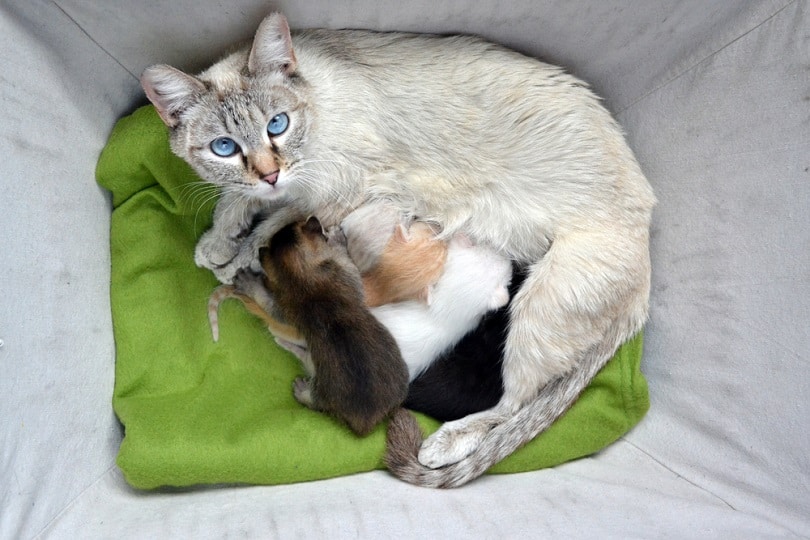Click to Skip Ahead
You may be a Siamese lover, but what happens when you mix a high-strung, strong-willed Siamese with a friendly, lazy tabby cat? You get the Lynx Point Siamese. They have a gorgeous coat and fascinating character combination.
Breed Overview
Height:
9–10 inches
Weight:
6–12 pounds
Lifespan:
15–20 years
Colors:
Apricot, cinnamon, red, caramel, seal, blue, lilac, chocolate
Suitable for:
Multipet households, indoor living
Temperament:
Inquisitive, Energetic, Amiable, Affectionate
The Lynx Point Siamese got their name for their striking resemblance to the wild Lynx. Even though the Lynx Point was an accident, they are stunning specimens with much to contribute. Let’s find out all about this adorable feline to see if they’re a perfect match.
 Lynx Point Siamese Characteristics
Lynx Point Siamese Characteristics

 3 Little-Known Facts About the Lynx Point Siamese
3 Little-Known Facts About the Lynx Point Siamese
1. The Lynx Point Siamese Was An Accident
The original breeding of the Lynx Point Siamese cats was accidental and occurred when a Seal Point Siamese mated with a Tabby cat. The personality traits of the Lynx Point were so pleasing it encouraged further breeding in the 1960s.
2. There’s Really No Such Thing As a ‘Lynx Point Siamese’
The Lynx Point Siamese isn’t an actual breed. The American Cat Fanciers’ Association refers to cats with these markings and breeding as a Lynx ColorPoint Shorthair. The Government Council of the Cat Fancy refers to them as a Tabby Point Siamese.
They’re also known by other, less official names like Tabby Points and Colorpoint Shorthairs.
3. They are Supposed To Be a “Watered-Down” Version of The Traditional Siamese
Although the Siamese have feisty attitudes, these cats are a less feisty version. Tabby cats usually have very docile, sweet temperaments, which balance things out.

 Temperament & Intelligence of the Lynx Point Siamese
Temperament & Intelligence of the Lynx Point Siamese
While they aren’t as high-strung as the traditional Siamese, Lynx Points have a mind of their own. When it comes to intelligence, they are sharp, quick, and agile. They have a playful spirit and are always ready for action.
Lynx Points can be curious to the point of nosiness. They always have to be involved in everything, and they may invade your personal space, which can be strange for some cat owners. Siamese can be one of the most challenging breeds because of their territorial nature and need for attention. But when you mix that with the slow-paced, relaxed tabby cat, you get a mild version of the Siamese.
Are These Cats Good for Families?
Lynx Points can make ideal additions to any family, even though they can be particular. They have high energy, so they can make very good companions for children. However, they may show less interest in smaller children since they’re more erratic and unpredictable.
However, you can teach your child to give your cat space and monitor their interactions. Since a Lynx Point is inquisitive, they should never be outside unattended. They follow their curious desires and can get lost while they venture. But they will love to spend hours at windows, looking out into nature to see birds flying around.
The Lynx Point probably won’t be an all-day catnapper, but they may be more relaxed than a Siamese, making them big-time cuddlers. If they take after the Siamese more, they might enjoy playing more and have more energy.
Does This Breed Get Along with Other Pets?
If Lynx Points are raised with other pets in the home, they generally do very well. However, if you introduce new pets once the cat is established and set in their ways, they could be less tolerant. But most of the time, they will be your dog’s best buddy or a cat’s sunbathing window pal.
Because of their prey drive, allowing them around smaller pets and rodents isn’t the best idea. You may have a cat who will love the house bunny or hamster, but it’s rare and probably not worth the risk. Since cats are carnivores, the wrong move by a small mammal could trigger unwanted consequences.
Cats who haven’t been spayed or neutered can get aggressive with other cats if they feel their territory is at risk. They can spray—and yes, both males and females can spray. However, fixing them before the age of 6 months is an excellent preventative measure you can take as an owner.

Things to Know When Owning a Lynx Point Siamese:
Food & Diet Requirements 
Your Lynx Point Siamese can benefit from a high-quality cat food that’s high in protein. Dry food usually has more protein than wet formulas, but they’re low in moisture. If you are worried that your kitty isn’t getting enough moisture in their diet, you can feed them wet and dry food.
If you adopt a kitten, they’ll need a meal every 2 to 3 hours, but adult cats can thrive on two meals a day. Your veterinarian can help you determine the correct portion to feed your Lynx Point, based on their age, weight, and health.
Exercise
Unlike some house cats, you probably won’t have to coax a Lynx Point to play with you. They are highly energetic and ready to romp at a moment’s notice. They love to chase toys around the house, and they’ll keep you entertained for hours.
As they age, their energy levels may go down slightly, and they mellow out once they are spayed or neutered. Senior Lynx Points usually still play around to release their energy, but sometimes they need a little incentive.
Like many fixed housecats, Lynx Points are prone to packing on extra pounds, and it’s essential to serve a well-balanced diet without overfeeding them (no matter their demands).
Training
You should find that your Lynx Point Siamese picks up on routines quickly. Litter box training should come easily to them. Since they’re so curious, teaching them tricks is simple. You can train your cat to fetch, but they might not be keen on returning the item.
As any cat lover knows all cats have a mind of their own. They won’t feel obligated if they don’t want to do something, but the Lynx Point is relatively easy to train compared to other cats.
Grooming
When it comes to grooming, the Lynx Point doesn’t need special care. Their soft short coat requires weekly brushing, and they shed less than other breeds. Although their coat is simple to maintain, they still require frequent tooth brushing and monthly nail clips. Ideally, you should brush your pet’s teeth two to three times a week, but brushing them weekly is the minimum.
Health and Conditions
When it comes to genetic conditions, these cats have few concerns. But since the Lynx Point is a mixed breed, they can pick up issues from either parent. Keeping up with regular vetting can get you ahead of any problems that could develop over their lifetime.
- Gastrointestinal Issues—Lynx Points can experience stomach and intestinal issues of various sorts.
- Gum Disease—Especially with age, Lynx Points can suffer from gum disease and other dental issues.
- Progressive Retinal Atrophy—this is a disease where the components of the eye slowly deteriorate, leading to eventual blindness.
- Feline Asthma –This feline form of asthma is caused by air irritants.
- Neoplastic Problems—This is the rapid growth of unwanted cells, leading to tumors and cancers.
 Male vs. Female
Male vs. Female
Females tend to be more selective about who they like. They may have one person they love while only tolerating others. Some are extremely social with everyone, but it’s rarer. Females are also a bit moodier than their male counterparts.
Males are a little wilder and crazier but also more lovable. They also might be more tolerant of smaller kids or rowdier pets. They can develop territorial behaviors like spraying or same-sex aggression before they’re neutered.
 Final Thoughts
Final Thoughts
If you want to add a Lynx Point Siamese cat to your home, now you know what to expect. These curious, affectionate companions make terrific additions for most living situations. Just remember, they aren’t the best candidates for unsupervised outside visits. Otherwise, they bring lots of energy, happiness, and amusement wherever they go.
If you have your heart set on a Lynx Point Siamese, remember to always check with local rescues and shelters to give a homeless kitty a new future.
Looking for information on more color-pointed Siamese cats? Check out:
- Chocolate Point Siamese Cat Info: Rarity, Facts, Traits & Pictures
- Flame Point Siamese Cat Info: Rarity, Facts, Traits & Pictures
Featured Image Credit: Mackenzie Kilmer, Shutterstock



 Lynx Point Siamese Characteristics
Lynx Point Siamese Characteristics 3 Little-Known Facts About the Lynx Point Siamese
3 Little-Known Facts About the Lynx Point Siamese Temperament & Intelligence of the Lynx Point Siamese
Temperament & Intelligence of the Lynx Point Siamese
 Male vs. Female
Male vs. Female Final Thoughts
Final Thoughts






